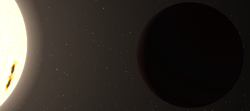Astronomy:WASP-4
From HandWiki
Short description: G-type main sequence star in the constellation Phoenix
| Observation data Equinox J2000.0]] (ICRS) | |
|---|---|
| Constellation | Phoenix[1] |
| Right ascension | 23h 34m 15.0857s[2] |
| Declination | −42° 03′ 41.048″[2] |
| Apparent magnitude (V) | 12.468±0.025[3] |
| Characteristics | |
| Evolutionary stage | Main sequence |
| Spectral type | G7V[4] |
| Apparent magnitude (V) | 12.468±0.025[3] |
| Apparent magnitude (B) | 13.216±0.020[3] |
| Variable type | Planetary transit variable[4] |
| Astrometry | |
| Radial velocity (Rv) | 57.61±0.76[2] km/s |
| Proper motion (μ) | RA: 9.950(12)[2] mas/yr Dec.: −87.620(10)[2] mas/yr |
| Parallax (π) | 3.6623 ± 0.0147[2] mas |
| Distance | 891 ± 4 ly (273 ± 1 pc) |
| Details[5] | |
| Mass | 0.89±0.01 M☉ |
| Radius | 0.920±0.060 R☉ |
| Surface gravity (log g) | 4.484+0.037−0.047[6] cgs |
| Temperature | 5436±34 K |
| Metallicity [Fe/H] | −0.050±0.040 dex |
| Rotation | 22.2±3.3 d |
| Rotational velocity (v sin i) | 2.2+0.6 −1.0 km/s |
| Age | 7.0±2.9 Gyr |
| Other designations | |
| Database references | |
| SIMBAD | data |
WASP-4 is a G-type main-sequence star approximately 891 light-years away in the constellation of Phoenix.[4][1][2] Despite its advanced age, the star is rotating rapidly, being spun up by the tides raised by a giant planet on a close orbit.[8]
Planetary system
In 2007 the exoplanet WASP-4b was discovered orbiting this star. With an orbital period of just 1.3 days it is classified as a hot Jupiter.[4] The planet's orbital period appears to be decreasing at a rate of 7.33±0.71 milliseconds per year, suggesting that its orbit is decaying, with a decay timescale of 15.77±1.57 million years. Another superjovian planet in the system is suspected.[9]
| Companion (in order from star) |
Mass | Semimajor axis (AU) |
Orbital period (days) |
Eccentricity | Inclination | Radius |
|---|---|---|---|---|---|---|
| b | 1.164±0.082 MJ | 0.02239±0.00084 | 1.338231587(22) | <0.0033[5] | 88.02±0.69° | 1.312±0.045 RJ |
| c (unconfirmed) | ≥5.47±0.44 MJ | 6.82±0.25 | 7001.0±6.6 | — | — | — |
See also
- SuperWASP
- List of extrasolar planets
References
- ↑ 1.0 1.1 Roman, Nancy G. (1987). "Identification of a Constellation From a Position". Publications of the Astronomical Society of the Pacific 99 (617): 695–699. doi:10.1086/132034. Bibcode: 1987PASP...99..695R. Vizier query form
- ↑ 2.0 2.1 2.2 2.3 2.4 2.5 Vallenari, A. et al. (2022). "Gaia Data Release 3. Summary of the content and survey properties". Astronomy & Astrophysics. doi:10.1051/0004-6361/202243940 Gaia DR3 record for this source at VizieR.
- ↑ 3.0 3.1 3.2 Henden, A. A. et al. (2016). "VizieR Online Data Catalog: AAVSO Photometric All Sky Survey (APASS) DR9 (Henden+, 2016)". VizieR On-line Data Catalog: II/336. Originally Published in: 2015AAS...22533616H 2336. Bibcode: 2016yCat.2336....0H. Vizier catalog entry
- ↑ 4.0 4.1 4.2 4.3 Wilson, D. M. et al. (2008). "WASP-4b: A 12th Magnitude Transiting Hot Jupiter in the Southern Hemisphere". The Astrophysical Journal Letters 675 (2): L113–L116. doi:10.1086/586735. Bibcode: 2008ApJ...675L.113W.
- ↑ 5.0 5.1 Bonomo, A. S. et al. (June 2017). "The GAPS Programme with HARPS-N at TNG. XIV. Investigating giant planet migration history via improved eccentricity and mass determination for 231 transiting planets". Astronomy & Astrophysics 602: A107. doi:10.1051/0004-6361/201629882. Bibcode: 2017A&A...602A.107B.
- ↑ Dragomir, Diana; Kane, Stephen R.; Pilyavsky, Genady; Mahadevan, Suvrath; Ciardi, David R.; Zachary Gazak, J.; Gelino, Dawn M.; Payne, Alan et al. (2011). "Terms Photometry of Known Transiting Exoplanets". The Astronomical Journal 142 (4): 115. doi:10.1088/0004-6256/142/4/115. Bibcode: 2011AJ....142..115D.
- ↑ "WASP-4". SIMBAD. Centre de données astronomiques de Strasbourg. http://simbad.u-strasbg.fr/simbad/sim-basic?Ident=WASP-4.
- ↑ Maxted, P. F. L.; Serenelli, A. M.; Southworth, J. (2015), "A comparison of gyrochronological and isochronal age estimates for transiting exoplanet host stars", Astronomy & Astrophysics 577: A90, doi:10.1051/0004-6361/201525774, Bibcode: 2015A&A...577A..90M
- ↑ 9.0 9.1 Turner, Jake D.; Flagg, Laura; Ridden-Harper, Andrew; Jayawardhana, Ray (2022), "Characterizing the WASP-4 System with TESS and Radial Velocity Data: Constraints on the Cause of the Hot Jupiter's Changing Orbit and Evidence of an Outer Planet", The Astronomical Journal 163 (6): 281, doi:10.3847/1538-3881/ac686f, Bibcode: 2022AJ....163..281T
External links
- "SuperWASP Homepage". http://www.superwasp.org/.
- "UK planet hunters announce three new finds". 2007-10-30. http://www.superwasp.org/press_release2/WASP2007_national_pressV5.pdf.
Coordinates: ![]() 23h 34m 15.06s, −42° 03′ 41.1″
23h 34m 15.06s, −42° 03′ 41.1″
 |


